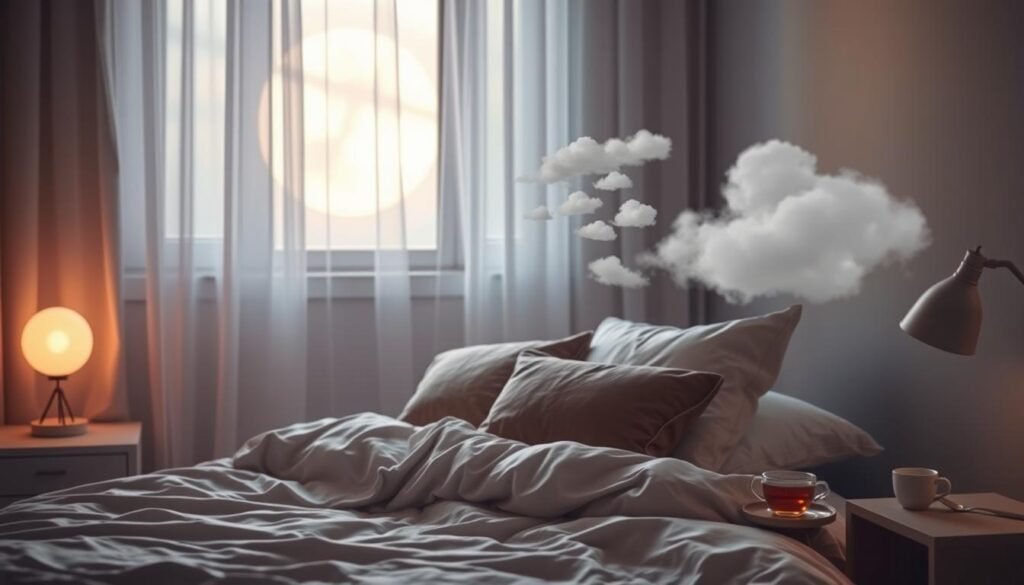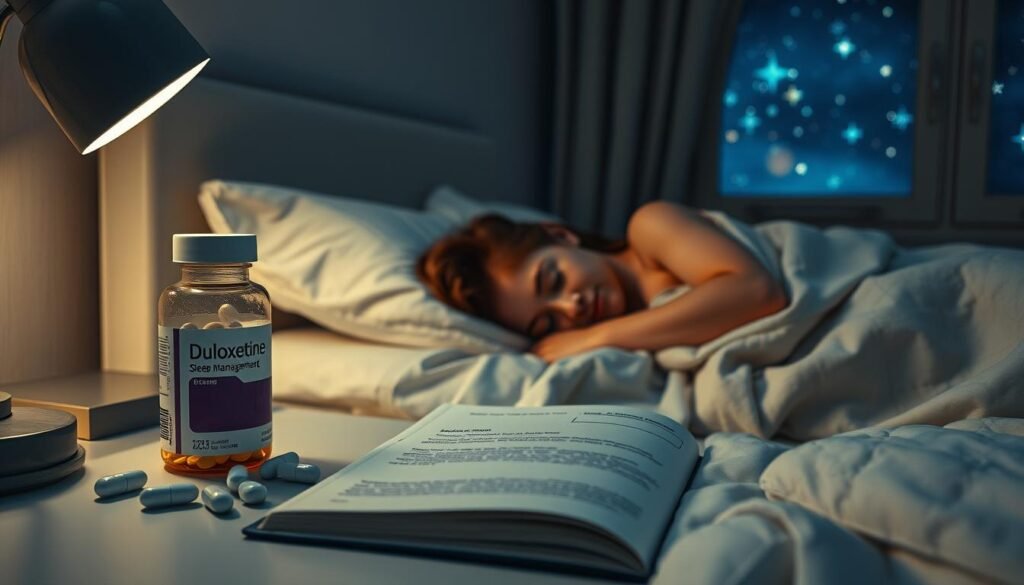Did you know a lot of people with major depression, 60-90%, also have insomnia? This fact shows how closely related mental health and sleep are. It points out why we should look into treatments like duloxetine. This drug is a serotonin-norepinephrine reuptake inhibitor. It helps with mood disorders and sleep issues. Learning how it works can tell us a lot about its effect on sleep and health.
Duloxetine affects how neurotransmitters work. It also changes the structure of sleep patterns. Studies show it alters serotonin and norepinephrine, affecting sleep cycles. This piece will explore how duloxetine can reduce sleep problems caused by anxiety. We’ll also see how it can help people with chronic pain sleep better.
Key Takeaways
- Duloxetine is a serotonin-norepinephrine reuptake inhibitor that affects sleep quality.
- Research shows that significant numbers of depressed patients experience sleep disturbances.
- The medication alters neurotransmitter balances, impacting sleep architecture.
- Duloxetine may be beneficial for anxiety and chronic pain patients dealing with insomnia.
- Understanding these mechanisms is essential for improving patient care and treatment outcomes.
Introduction to Duloxetine
Duloxetine is an antidepressant known as a serotonin-norepinephrine reuptake inhibitor (SNRI). It’s key for treating depression and anxiety. Increasing serotonin and norepinephrine levels in the brain is how it works. These neurotransmitters are vital for mood control.
Duloxetine helps with mental health and chronic pain, including fibromyalgia. It’s approved for adults and kids 7 and up, showing its wide use. However, some young people might have suicidal thoughts while on it. So, close watching is crucial.
Knowing about duloxetine’s side effects is important. Nausea, dry mouth, dizziness, and tiredness are common. But, serious issues like serotonin syndrome and liver damage need quick doctor visits. Knowing the good and bad helps use it right for many people.
The Mechanism of Action of Duloxetine and Its Effect on Sleep
Duloxetine has a special way of working that changes neurotransmitter levels in the brain. Being a serotonin-norepinephrine reuptake inhibitor (SNRI), duloxetine helps control serotonin and norepinephrine. These are important for mood and feeling well.
Neurotransmitters Involved
Duloxetine’s effect comes from its interaction with neurotransmitters. It stops serotonin and norepinephrine from being taken back up, making more of them available. This not only boosts mood but also affects sleep in a big way.
Changing levels of these neurotransmitters is key to how we sleep. It affects both REM and non-REM sleep.
Impact on Serotonin and Norepinephrine Levels
Serotonin impacts mood, anxiety, and how well we sleep. More serotonin means you can fall asleep faster. Norepinephrine, on the other hand, helps control alertness.
When something is off with these neurotransmitters, sleep problems like insomnia can happen. Studies show that duloxetine helps balance them out. This means people can have a better sleep pattern.
https://www.youtube.com/watch?v=R2z0y_xnvzs
| Neurotransmitter | Impact on Mood | Effect on Sleep |
|---|---|---|
| Serotonin | Improves mood and reduces anxiety | Decreases sleep latency; promotes REM sleep |
| Norepinephrine | Regulates alertness and anxiety | Affects wakefulness; can disrupt non-REM sleep |
Duloxetine’s Role in Treating Anxiety Disorders
Duloxetine is a key player in treating anxiety disorders, including generalized anxiety disorder (GAD). GAD affects many people, with around 18.1% incidence and 28.8% lifetime chance in the U.S. These disorders can badly affect sleep, making symptoms worse. Duloxetine boosts serotonin and norepinephrine levels. This helps tackle anxiety symptoms and improves sleep quality.
Addressing Anxiety-Induced Sleep Issues
Sleep problems are a big hurdle in treating anxiety disorders. GAD often goes hand in hand with other medical issues, messing up sleep even more. Duloxetine addresses these sleep challenges directly. It reduces anxiety and helps users sleep better. This improved sleep is crucial for treating the whole patient.
Patient Testimonials and Case Studies
Patient stories highlight duloxetine’s role in combating anxiety and improving sleep. Users often notice a big change in managing anxiety and sleeping better after starting duloxetine. These experiences show the drug’s positive effects on mental health and well-being.
Duloxetine and Chronic Pain Management
Chronic pain can really mess with your sleep. It makes it hard to fall asleep and stay asleep. This issue can make your pain feel worse. It then harms your overall health. It’s key to understand how chronic pain and sleep problems are linked. That way, we can see why treatments like duloxetine matter.
How Chronic Pain Affects Sleep Quality
Chronic pain keeps waking you up, stopping you from getting deep sleep. This lack of sleep hurts your mental and physical health. People with chronic pain struggle because:
- They feel more pain at night
- They have muscle tension and discomfort
- They’re stressed about their pain
All these issues mean their sleep isn’t great. This makes finding good pain treatments even more important.
Duloxetine’s Efficacy in Reducing Pain-Related Sleep Disturbances
Duloxetine helps with chronic pain. It does more than just ease the pain. It also helps you sleep better by dealing with pain that keeps you up. Research shows it works for different kinds of chronic pain. People with musculoskeletal pain, fibromyalgia, and diabetic neuropathy sleep better with it.
People taking duloxetine have seen:
- Fewer times waking up at night
- Better overall sleep quality
- Less tiredness and pain during the day
These improvements show how vital duloxetine is. It helps those with chronic pain sleep better and live better.

Effects on Sleep Architecture
Duloxetine impacts not just mood but also how we sleep. It changes the structure of sleep in important ways. Those with depression often struggle to sleep well. It’s key to know how treatments like duloxetine can change sleep. They can affect both REM sleep and non-REM sleep stages.
Changes in REM Sleep Patterns
Duloxetine can cut REM sleep time quite a bit, from about 132 minutes to just 49.5 minutes. This loss affects how we think and handle emotions. It shapes our overall health and how we recover from mood disorders. As REM sleep changes, the time it takes to start dreaming may increase. This interrupts the normal pattern of our sleep.
Adjustments in Non-REM Sleep Stages
Duloxetine also alters non-REM sleep, which makes up around 80% of our sleep. This phase has three levels, and the deepest is N3. Changes here can lead to broken sleep cycles and less restorative sleep. This is crucial for both mental and physical well-being. People taking duloxetine might find their sleep less deep and not as continuous.
Duloxetine’s Impact on Insomnia
Insomnia is a big problem for depressed patients, making their condition more complex. It greatly lowers their quality of life by causing a cycle of sleep problems and deeper depression. Duloxetine helps treat both depression and insomnia. Knowing how insomnia shows up in these patients and using good sleep management can make a big difference in their lives.
Understanding Insomnia in Depressed Patients
Insomnia is common in those with major depression, affecting nearly 15% of people at some time. More women suffer from it, showing that sleep troubles can make mental distress worse. Duloxetine, a drug that helps balance mood and sleep chemicals in the brain, is crucial in treating both depression and insomnia.
Strategies for Managing Insomnia with Duloxetine Treatment
Effective sleep management for patients on duloxetine may include:
- Dosage Management: Changing duloxetine’s dosage can help lessen insomnia. Doctors need to watch this closely.
- Complementary Therapies: Adding therapy for insomnia, like CBT, can improve results with duloxetine.
- Sleep Hygiene Improvements: Teaching patients to keep a regular sleep schedule and make their bedroom restful helps improve sleep.
Studies show duloxetine helps reduce insomnia in depressed patients. To learn more about duloxetine and depression, visit this resource. Effective strategies tackle insomnia and take care of depression in a comprehensive way.

| Strategy | Description |
|---|---|
| Dosage Management | Adjusting duloxetine dosage based on individual response can improve sleep quality. |
| Complementary Therapies | Combining duloxetine with cognitive-behavioral therapy enhances treatment effectiveness. |
| Sleep Hygiene Improvements | Implementing techniques for a conducive sleep environment promotes better rest. |
Clinical Studies on Duloxetine and Sleep
Recent studies have shed light on duloxetine’s impact on sleep. They reveal both the benefits and possible downsides of using duloxetine. This is crucial for those considering it as a treatment.
Recent Research Findings
A huge study involving 34,808 people was conducted, with 61.5% receiving duloxetine. Reports of nausea, dry mouth, and constipation were common among them. These side effects led to 59.5% of participants quitting the studies, mainly due to these issues. A systemic review showed that most of the research was made up of randomized controlled trials, 58.7% to be exact.
Half of the studies couldn’t find a significant link to heart issues. But, 11.8% of them did connect duloxetine with higher heart rates. It shows the importance of watching patients closely during treatment.
Long-Term Effects of Duloxetine on Sleep Patterns
The long-term effects on sleep from taking duloxetine deserve attention. Treatment seems to change sleep for better or worse, affecting how long and well people sleep. Some people might sleep better, but there’s always a risk for negative effects. Doctors need to watch patients carefully, making changes as needed to get the most from duloxetine without harming sleep.
Side Effects Related to Sleep
Duloxetine helps with depression, anxiety, and chronic pain but has side effects. Sleep disorders are significant ones to watch out for. Knowing about these helps doctors make better plans for their patients.
Identifying Potential Sleep Disorders Induced by Duloxetine
People using duloxetine might have trouble sleeping. Doctors need to check on this, as it can worsen anxiety. Treatments that mix medication and behavioral changes are often best.
Comparative Analysis with Other Antidepressants
Comparing duloxetine with others like Venlafaxine shows differences in sleep side effects. Duloxetine generally causes less severe sleep problems. This knowledge helps doctors choose the right treatment with fewer sleep-related side effects.

Dosing Considerations and Recommendations
Getting the dose right with duloxetine is key. We’ll talk about the best dosages for improving sleep. It’s also vital to keep an eye on patients to see how they’re doing during treatment.
Optimal Dosage for Sleep Improvement
Duloxetine comes in different strengths – 20, 30, 40, and 60 mg capsules. For fibromyalgia, folks usually start at 30 mg a day. Then, they might go up to 60 mg. With major depression, the starting dose is often between 40 mg and 60 mg each day. It shouldn’t go over 120 mg. For anxiety, it starts at 60 mg, with 120 mg as the max. These dosing considerations show us that each person’s needs are different.
Monitoring Patients for Sleep Quality Changes
It’s very important to watch how patients sleep while they’re on duloxetine. Because of possible side effects like not sleeping well or feeling sleepy, keeping track helps. Doctors need to catch any dose adjustments needed. Changes in how well the drug works might happen. This is because of things like getting older or changes in metabolism. Smoking can also lower how much drug is in the body by 30%, changing how well it works. So, talking openly and keeping notes on how patients feel can really help find the best way to use the drug.
Patient Care and Management Strategies
For duloxetine to work best, healthcare professionals use specific management strategies. They tailor these strategies to meet each patient’s needs. Knowing the clinician guidelines well helps in spotting sleep issues often missed in discussions.
Guidelines for Clinicians
Clinicians should always check the latest guidelines to give the best care. They must:
- Look into a patient’s history for insights on sleep and mental health.
- Watch for duloxetine’s side effects like trouble sleeping and being tired.
- Tweak dosages to get sleep and medication balance right.
Coordinating Care Between Mental Health and Sleep Specialists
To manage patients well, mental health and sleep experts must work together. This teamwork leads to better results for those with mental and sleep issues. To work well together, they should:
- Make sure there’s a clear way to send patients for special sleep checks.
- Share treatment plans for a united effort.
- Meet regularly to fine-tune how they care for patients.
Challenges in Treatment
Duloxetine poses several challenges for healthcare workers. They need to overcome these to help their patients fully. Problems like not responding to the drug and negative side effects make treatment hard. Dealing well with these issues is key for treating conditions such as major depressive disorder (MDD) and generalized anxiety disorder.
Watching patients closely and teaching them about their treatment helps overcome these hurdles.
Addressing Non-Response or Adverse Effects
Some patients might not get better with duloxetine, even if they take it as told. About 65% of people with MDD feel physical pain along with their mental health woes. Managing this pain is vital in their overall treatment.
Side effects like feeling sleepy, sick, or not being able to sleep can make treatment harder. These issues can make life worse and lead to patients not sticking with their treatment plan. It’s important to keep an eye on patients for these issues. Changing how much they take may be needed.
Strategies for Overcoming Treatment Barriers
There are ways to get past these treatment barriers. Teaching patients about possible side effects encourages them to be open about what they’re experiencing. Changing the amount they take or trying different medications can help those hit hard by side effects.
Getting mental health and pain experts to work together improves care. Keeping up with how patients are doing and listening to them makes sure the treatment fits their needs. This approach helps make the most of treatment while keeping problems to a minimum.
Future Directions in Duloxetine Research
Studying duloxetine deeply will help us know how it changes sleep and mood. Researchers want to find the best doses and see how it works with other treatments. It’s crucial to fill the current gaps in our knowledge to use duloxetine well.
What Studies Are Needed?
More research is needed to understand how duloxetine affects sleep over time and improves mood. By focusing on clear results, we can see how this drug helps with sleep and wellness. Future studies should look at:
- Assessing long-term effects of duloxetine on sleep quality across diverse populations.
- Investigating the interaction of duloxetine with other medications that affect sleep.
- Examining how varying dosages influence both mood stabilization and sleep improvement.
Potential for New Therapeutic Approaches
New treatment methods could make duloxetine work better and have fewer side effects. Using it with other therapies might help people with depression and sleep problems. Our goal is to have treatments that help both the mind and body. Future research should explore:
- Integrating duloxetine with behavioral therapies to enhance treatment outcomes.
- Exploring the potential of adjunctive therapies to reduce adverse effects of duloxetine.
- Identifying biomarkers that can personalize treatment based on individual responses.
| Research Areas | Description |
|---|---|
| Long-term Sleep Impact | Evaluating how duloxetine influences sleep quality over extended periods. |
| Medication Interactions | Understanding how duloxetine interacts with other sleep-affecting medications. |
| Dosing Effects | Investigating the relationship between dosage variations and treatment outcomes for sleep and mood. |
| Combination Therapies | Exploring the effectiveness of duloxetine paired with behavioral therapies or other medications. |
| Personalized Treatment | Identifying biomarkers for tailoring duloxetine therapy to individual patient needs. |
Conclusion
Duloxetine helps manage mood disorders and affects sleep patterns. It is well-researched for its benefits in treating depression and anxiety. It also helps with sleep problems that often come with these conditions.
Patients on duloxetine are usually older and deal with more health issues. So, knowing how it affects sleep is key to better treatment.
Many who take duloxetine have tried other treatments for depression and pain. This suggests they have complex health needs. Treating them with duloxetine can be more expensive than using other medicines, such as venlafaxine XR.
Understanding how duloxetine changes sleep patterns is important. Doctors must look at how each patient responds differently. These responses can vary widely.
Looking ahead, more studies on duloxetine and sleep will help shape better treatments. Healthcare workers need to keep up with its benefits and side effects on sleep. This will improve patient care and our knowledge of mental health treatments.